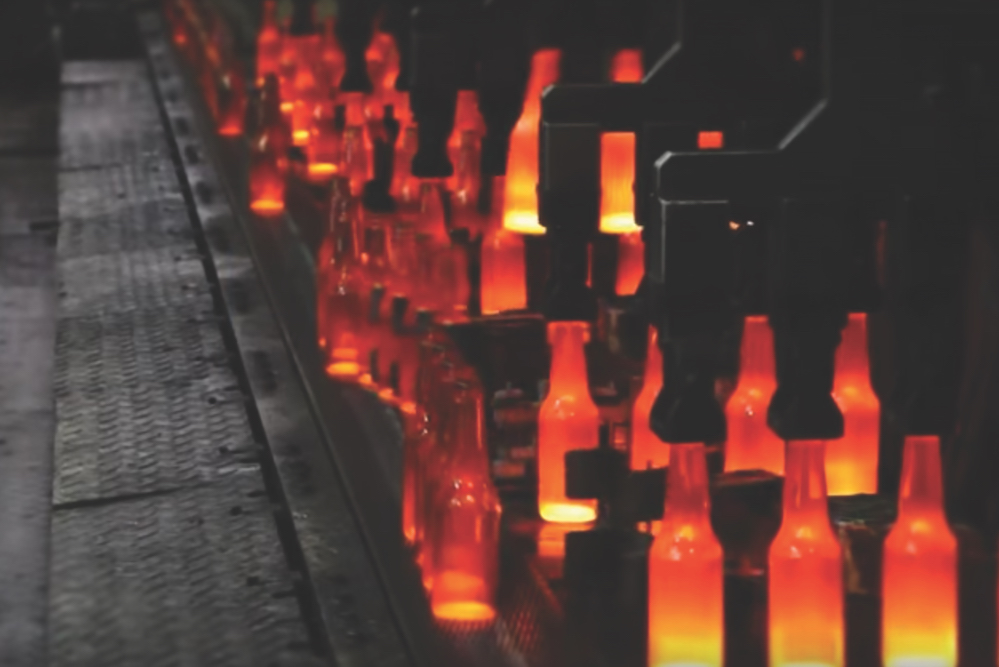
[Image above] Annealing, like other glass-making processes, requires knowledge of the glass transition temperature. Researchers created software that predicts glass transition temperatures without needing to make the glass. Credit: ClearerThinking, YouTube
Tour guides sometimes tell the common myth during tours of old European churches that the stained-glass windows are thicker at the bottom than at the top because glass flows like a liquid. Though this may sound reasonable to someone not versed in glass science—glass does go through a supercooled liquid stage before becoming a rigid, non-crystalline material—glass scientists know that glass is locked in a state of non-moving until the glass transition temperature is reached.
The glass transition temperature (Tg) of a glass is the temperature below which the atoms of a supercooled liquid are temporarily frozen without crystallizing. In other words, Tg is the temperature below which glass becomes a rigid, non-crystalline material. Knowing the Tg of a glass allows scientists and engineers to plan at what temperatures to conduct important glass-making processes, like annealing and thermal tempering (processes that remove internal stress), and how to avoid accidental devitrification (crystallizing the glass).
Because knowing a glass’s Tg gives scientists an idea of how the glass will behave during glass-making processes, finding the Tg is an important first step in testing new glass compositions. However, finding the Tg experimentally can be an expensive and time-consuming process.
Scientists mainly use the “cook and look” approach to finding Tg, meaning they make the glass to find the Tg. If there was a way to predict the Tg without actually making the glass, time and money could be saved developing new glass compositions. Current theoretical tools, however, only predict Tg for simple compositions, typically containing less than five different components. Commercially important compositions have many more constituents and much more complexity. Surely a software can be designed to handle more than five different components? Researchers at the Federal University of São Carlos created such a software in a recent article, using a specific form of machine learning.
ACerS Fellow and professor of materials science and engineering Edgar Dutra Zanotto and his coauthors Daniel R. Cassar and André C.P.L.F. de Carvalho at UFSCar used artificial neural networks (ANNs) to predict the Tg of oxide glasses containing anywhere from three to 21 elements. ANNs is a type of machine learning based on the structure and functions of biological neural networks, and has been used before in materials science to predict kinetic and mechanical properties of polymers. In the realm of oxide glasses, however, Zanotto identifies only two published studies using ANNs to predict properties.
The previous oxide studies using ANNs trained their models on small data sets, using 31 and 299 examples respectively. In the current research, Zanotto and his coauthors trained their ANN model with a dataset containing 55,150 examples.
The trained ANN correctly predicted published Tg values with 95 percent accuracy, and within less than ±9 percent error; additionally, 90 percent of the data was predicted with a relative deviation lower than ±6 percent. Zanotto and his coauthors also tested the ANN on approximately 5,000 compositions not included in the training dataset, with similar accuracy results.
While the prediction uncertainty did not depend on the number of elements in the glass composition, the uncertainty was larger for glasses with high Tg (above 1,250 K) because less than 0.2 percent of the dataset were these high-Tg glasses.
“At the moment, we are testing other types of predictors to check whether they can do a better job than the ANNs for these special cases of high- and low-Tg glasses,” Zanotto says in an email. “In the end, an optimized algorithm should predict high-Tg glasses compositions with a closer performance.”
Zanotto says they will launch a freely available beta version of the ANN with the current algorithm and dataset, but other, more powerful software is on the way. “[This software] will allow the glass community to predict the Tg of oxide glass compositions that have never been made,” Zanotto says.
In the future, Zanotto says they plan to do more research using ANNs. “We are training and testing other ANNs for three other important physical properties of inorganic glass-formers: liquidus temperature, elastic modulus, and refractive index,” Zanotto says.
The paper, published in Acta Materialia, is “Predicting glass transition temperatures using neural networks” (DOI: 10.1016/j.actamat.2018.08.022).
Updates 11/20/2018: 1) The definition of glass has been updated to read “rigid, non-crystalline material”; 2) The number of compositions not included in the dataset that the ANN was tested on has been corrected to approximately 5,000; 3) The names of Edgar Zanotto’s coauthors have been included
